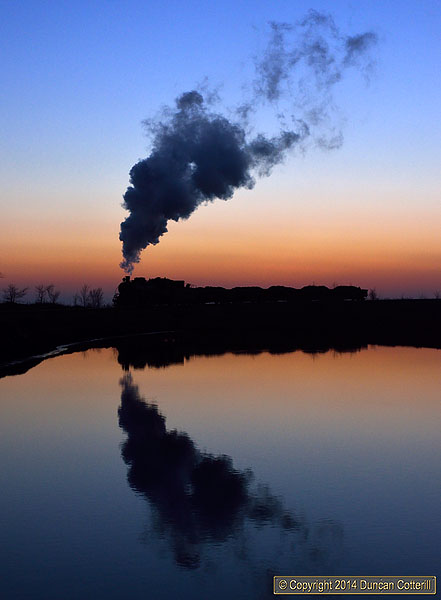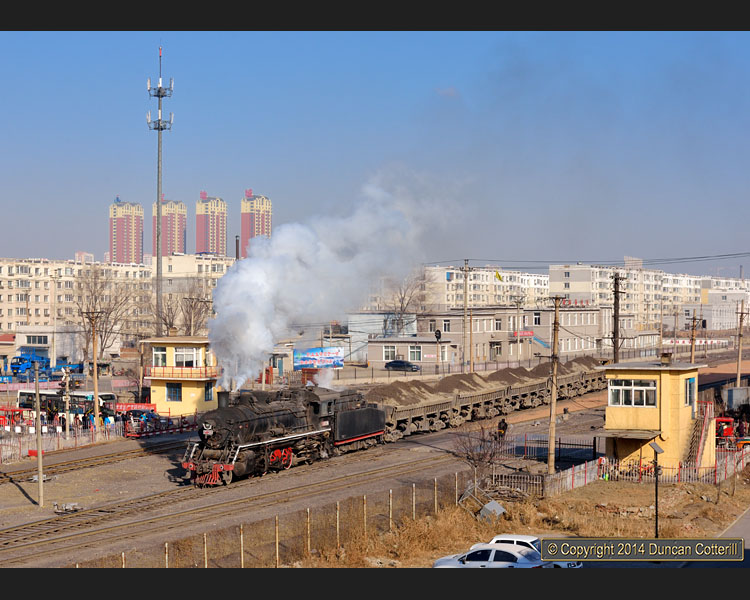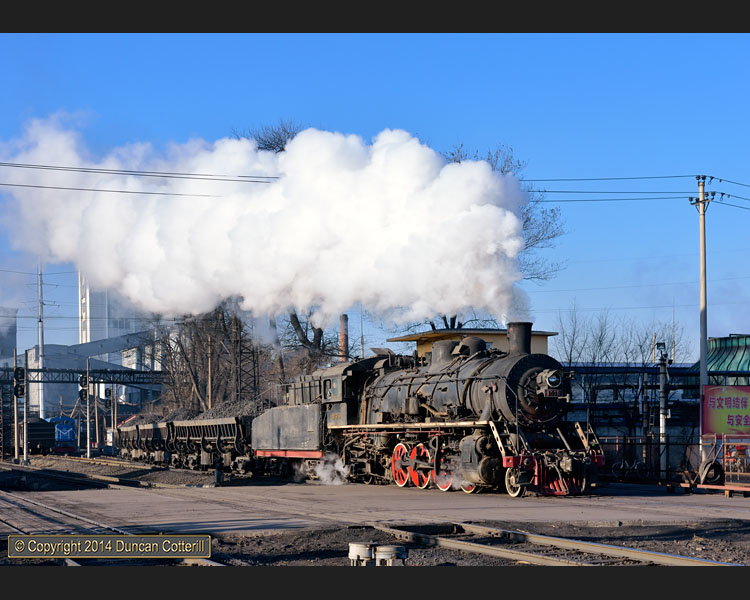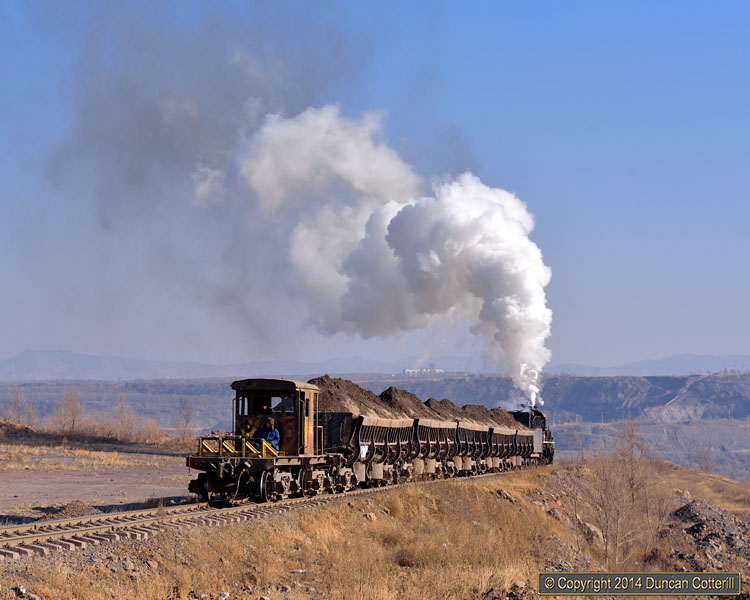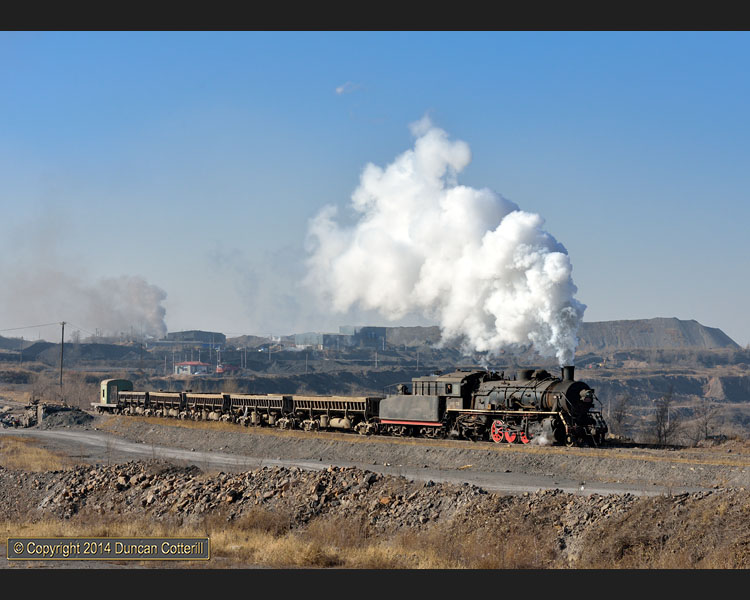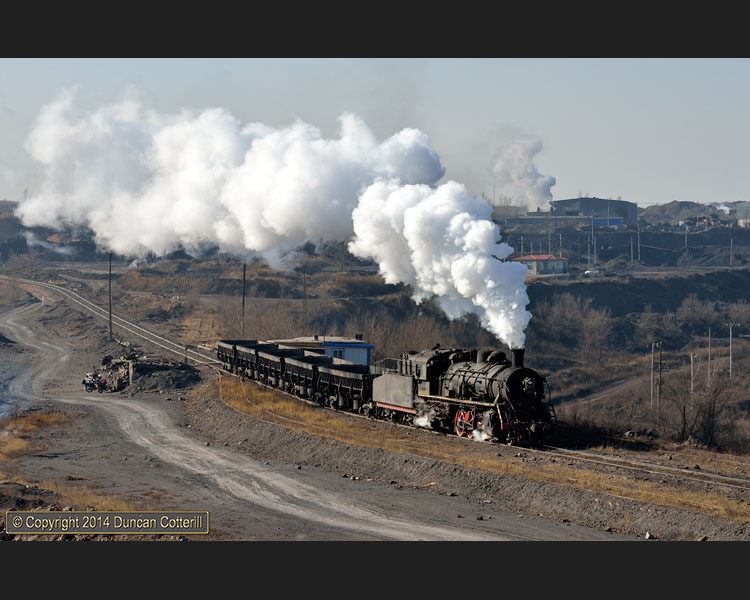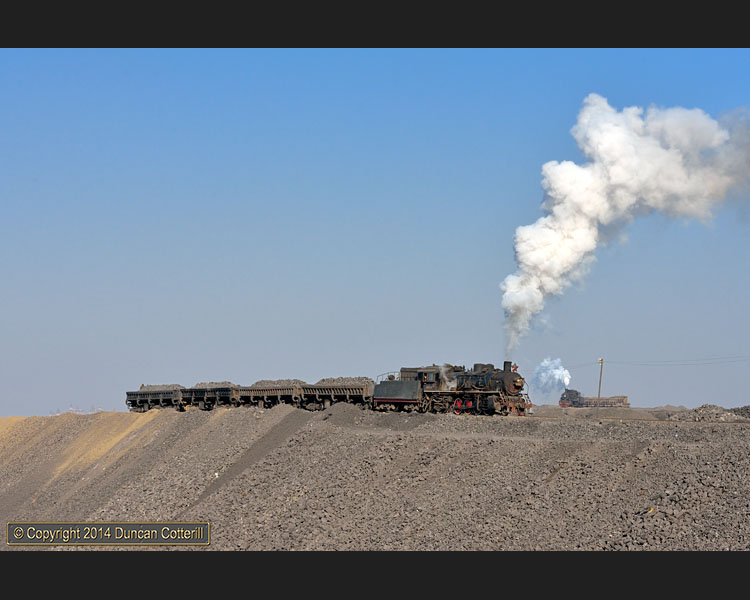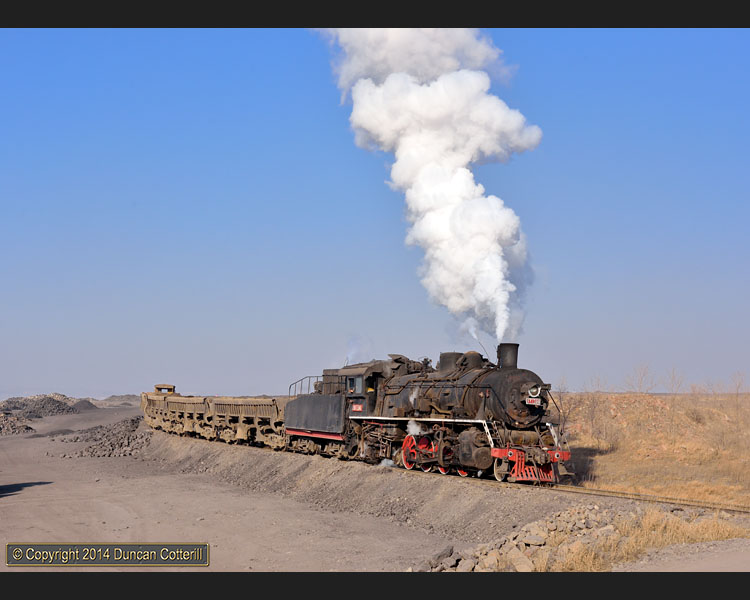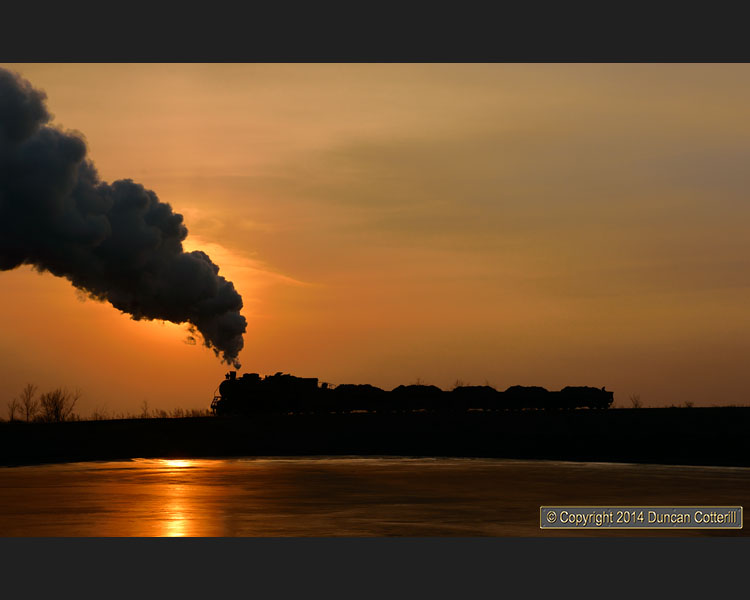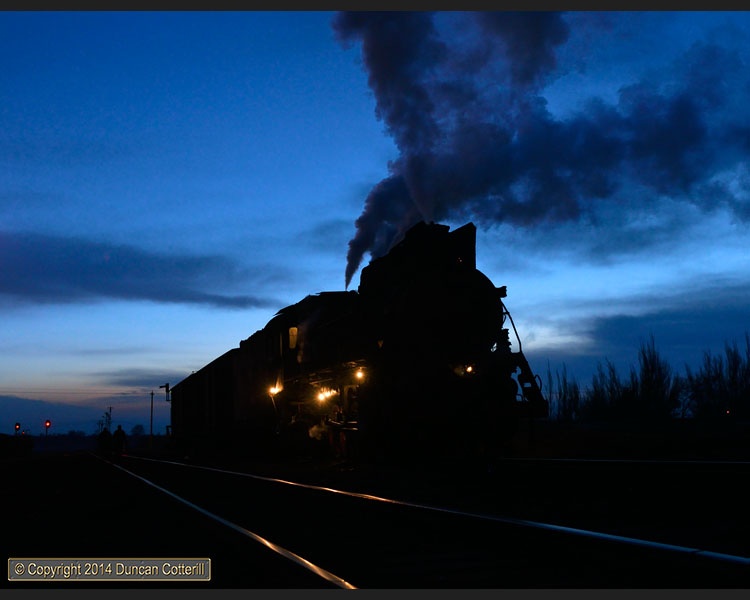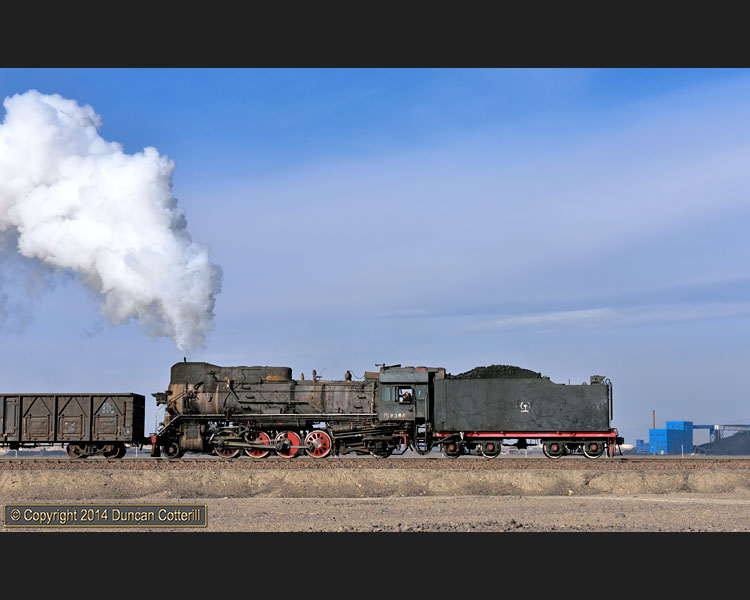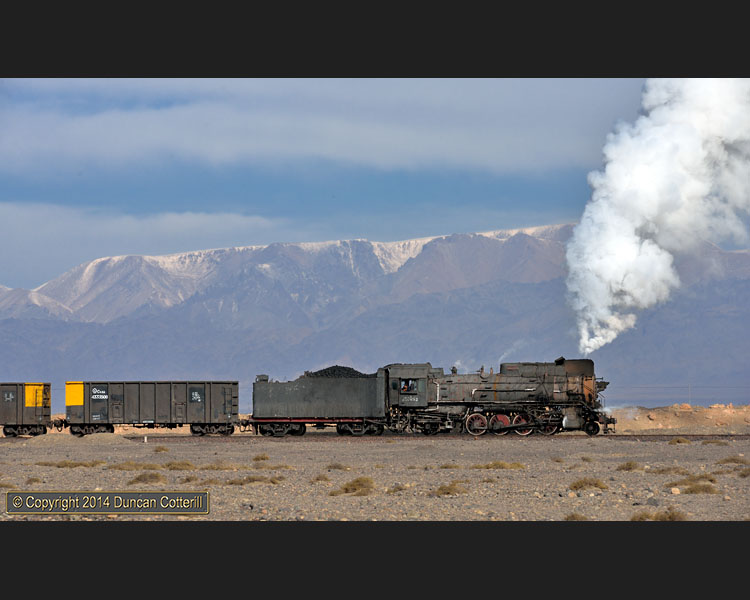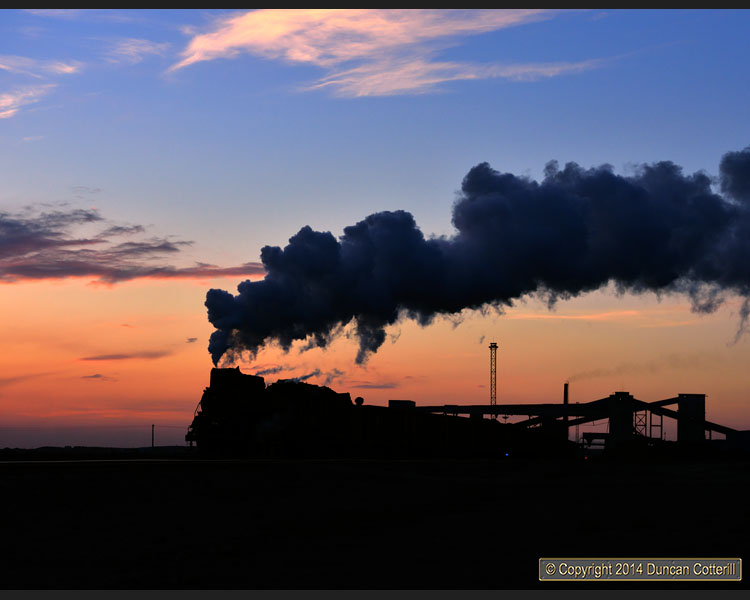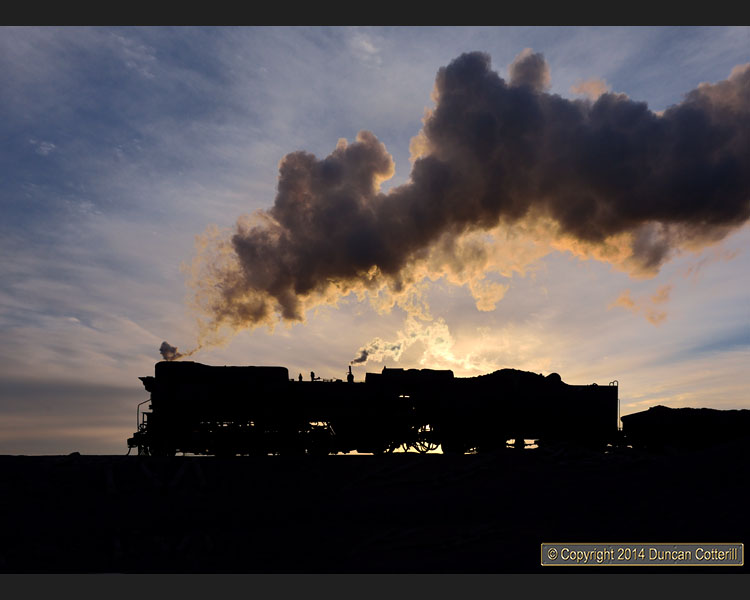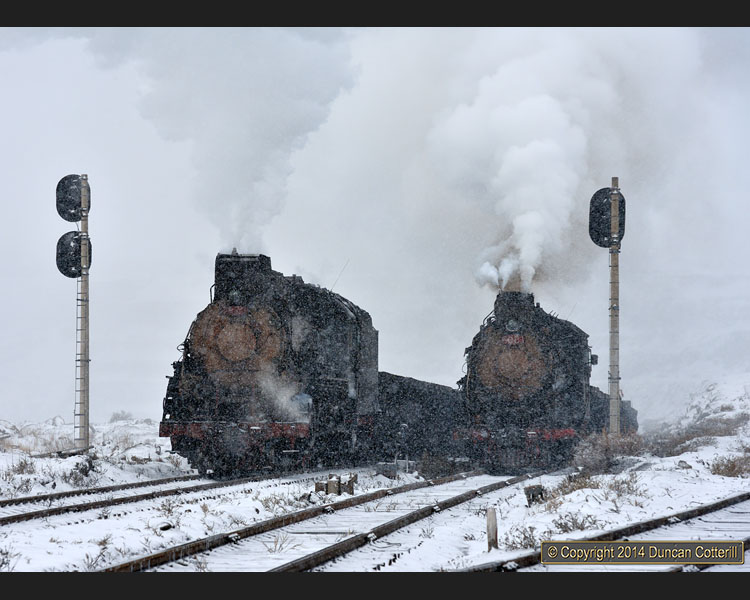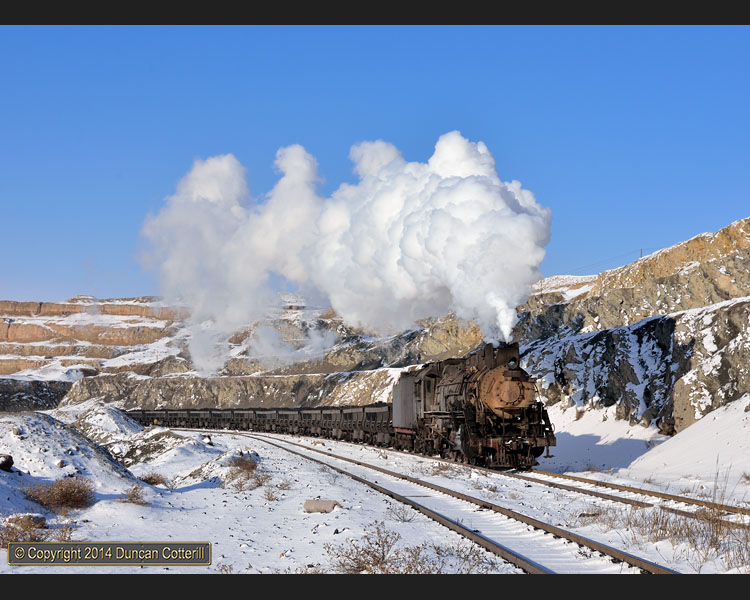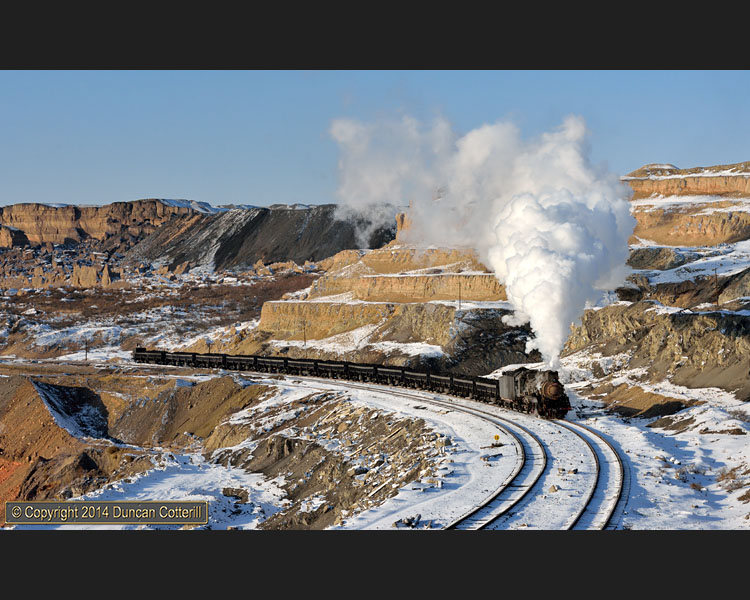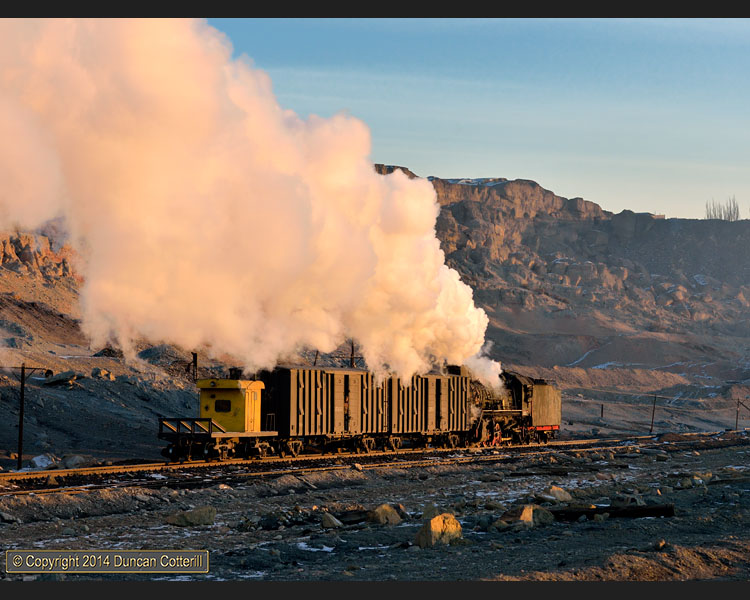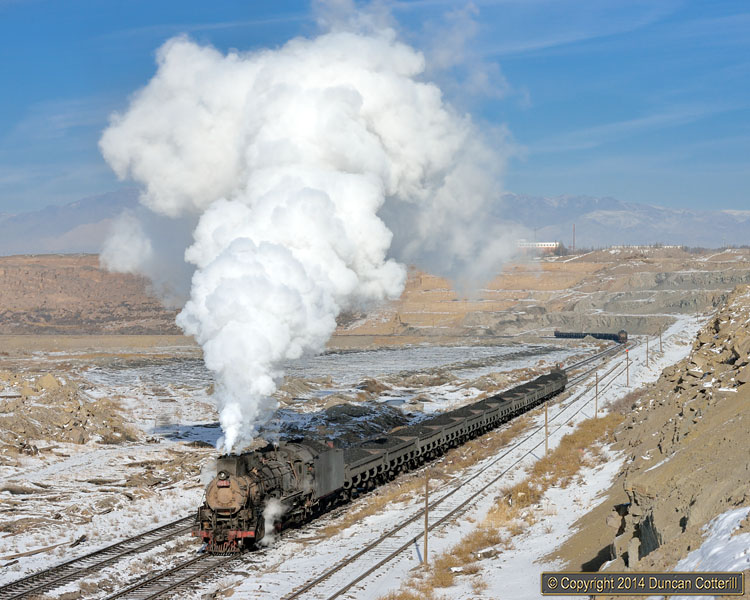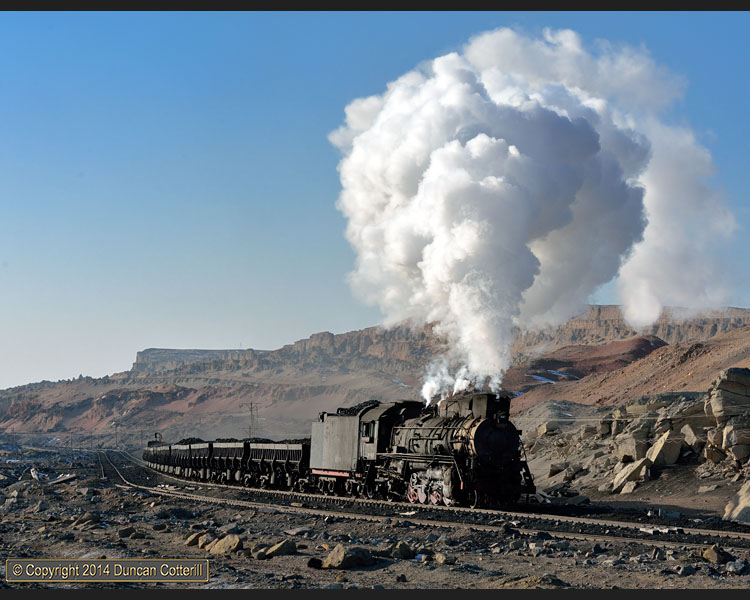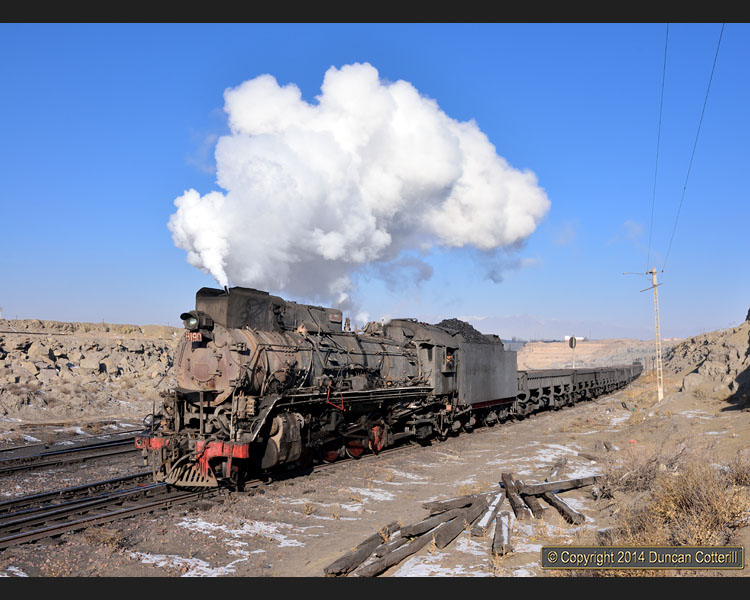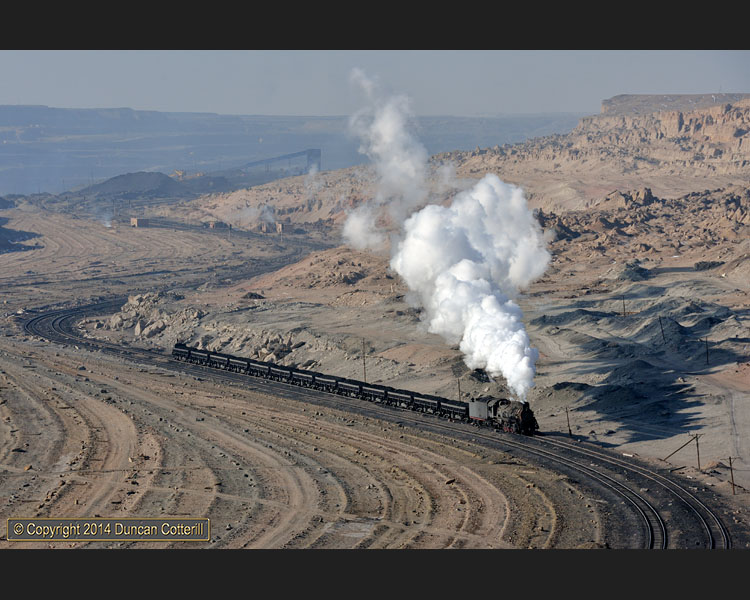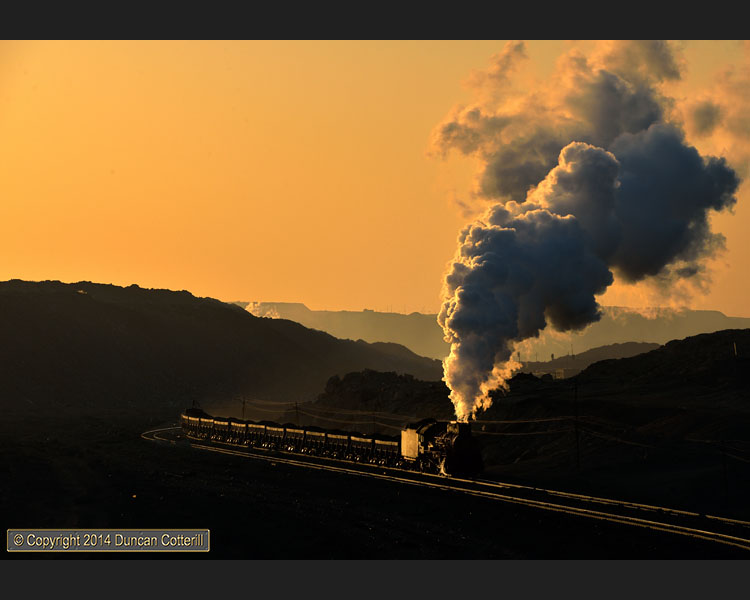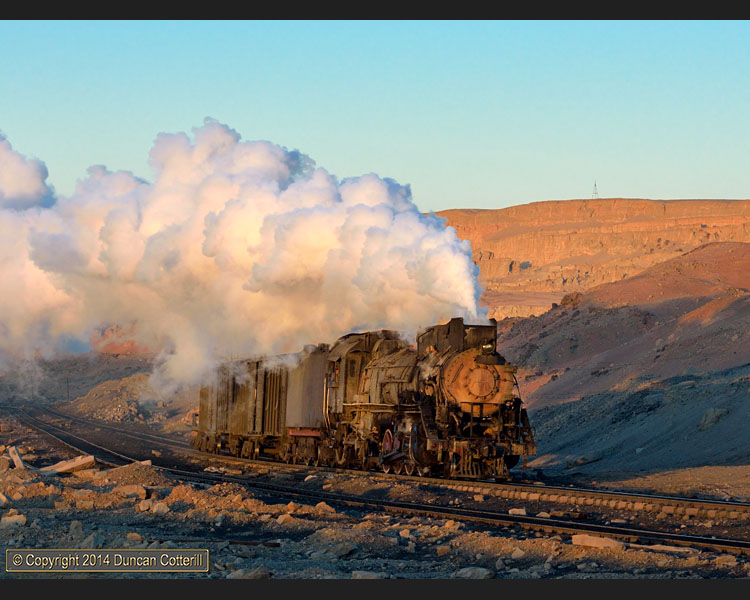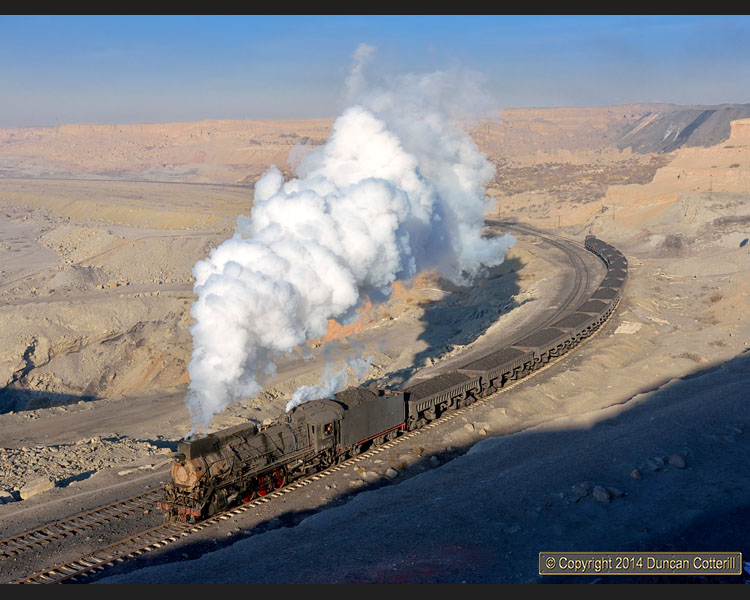DISAPPEARING STEAM
Two new steam lines seemed too good to be true, and it was…
China - 18 November to 10 December 2014 - Report by Duncan Cotterill
INTRODUCTION
The use of steam locomotives in China continues to decline but the prospect of a visit to the narrow gauge line at Rongshan, in an area only recently opened to foreigners, and getting JS hauled coal trains on a brand new line at Sandaoling was more than enough to justify another trip. Having two new steam lines to photograph at the end of 2014 seemed too good to be true and so it turned out to be.
I was accompanied by my usual companions, Peter Breeze and Sun Xiaolan, on this three week trip from 18 November to 10 December. Mike Dodd also joined us for the first two weeks.
The first blow came a few days before we were due to set off, when we got the news that the mines at Rongshan were to close imminently. There was little prospect of there being any rail activity by the time we got there so we decided to abandon our visit and split the time between Fuxin and Sandaoling. Fortunately there was just enough time for Xiaolan to change our travel arrangements before we left.
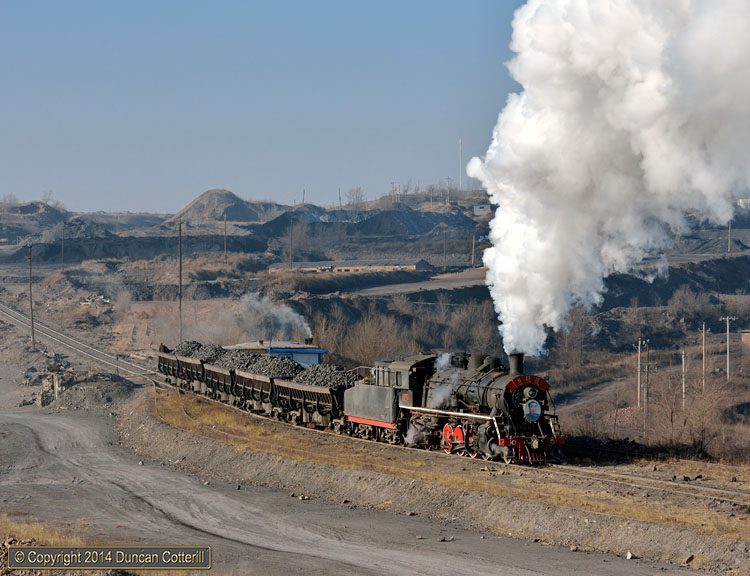
Rock ’n’ Rail
The spoil tipping operation at Fuxin continues to be 100% steam worked. Decorated SY1395 “Zhu De Hao” accelerated a loaded train up the Wulong tip after picking up the tipping crew from their bothy on 5 December 2014.HOME TO FUXIN
(18 to 19 November 2014)We flew from the UK to Beijing with Finnair via Helsinki, arriving in plenty of time to change money, meet Xiaolan and make our way to Beijing station by airport bus. Fast train D9, formed of CRH5 units 0089 and 0111, took us on to Jinzhou Nan. At Beijing I got my first glimpse of one of the new Dalian built HXD3D electrics, similar to the HXD3Cs but in a much more attractive red livery. More importantly they seem to be capable of 160km/h, making them much more suitable for express passenger work than their 120km/h HXD3C predecessors.
There were also plenty of HXD3C, SS9G, DF11 and DF11G locos around Beijing with DF4C handling most of the empty stock movements. A few DF4D, SS8 and SS9 were also seen and, very unexpectedly, DF12.0012 was at the loco depot. No less than three green DF4Bs were seen around Beijing Dong, more than on the last three trips put together.
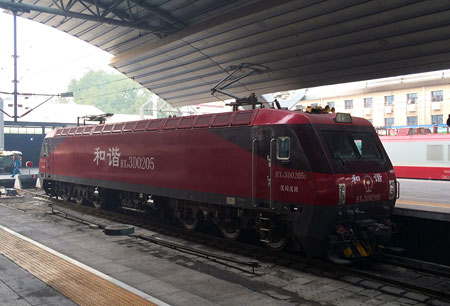
New Electric
HXD3D.0205 at the buffer stops at Beijing on 19 November 2014. These locally built 7.2MW locos are based on Bombardier designs.Virtually all freight traffic seen between Beijing and the Qinhuangdao/Shanhaiguan area was worked by Beijing Bureau HXD2B electrics with many Shenyang Bureau HXD3Bs being seen around Shanhaiguan.
On the passenger front, the most interesting observation was of DF11Z.0004 at Qinhuangdao with the empty stock of a Beijing - Nanjing service. The same loco was seen on the same train in the same place on two subsequent occasions during the trip so it appears to be regular at the moment. Decorated DF11.0128 seemed to be the regular power for the same train last winter. Most other passengers were hauled by SS9G, HXD3C or HXD3D but a number of DF11s were also seen on trains that could easily have been electrically hauled. The use of DF4Ds on long distance passengers on the route appeared to have declined significantly.
At Jinzhou Nan we were met by our driver, well known local photographer Gu Manchun, and driven to Fuxin.
On the passenger front, the most interesting observation was of DF11Z.0004 at Qinhuangdao with the empty stock of a Beijing - Nanjing service. The same loco was seen on the same train in the same place on two subsequent occasions during the trip so it appears to be regular at the moment. Decorated DF11.0128 seemed to be the regular power for the same train last winter. Most other passengers were hauled by SS9G, HXD3C or HXD3D but a number of DF11s were also seen on trains that could easily have been electrically hauled. The use of DF4Ds on long distance passengers on the route appeared to have declined significantly.
At Jinzhou Nan we were met by our driver, well known local photographer Gu Manchun, and driven to Fuxin.
FUXIN MINING RAILWAY
(20 to 23 November 2014)The number of locomotives in service has dropped dramatically since last November with only five or six SYs steamed daily and only two diesels in use. Four of the SYs covered all the work with the other one or two on standby at the depot. There didn't seem to be much of a reduction in activity though, so each loco must have been doing significantly more work than last year. The time taken for the morning shift change gathering at Ping'an was also noticeably shorter than before, with every loco usually back at work by 08:30. The locos were also dirtier than in previous years, possibly due to the crews having less time to clean them between duties.
SY 1319, 1320, 1359, 1378, 1395 and 1396 were all seen in steam over the period of our visit. SY 1460 is also apparently part of the working fleet but is currently in works. SY 1195, 1210, 1397 and 1414 (1818) are thought to be in store at the works but weren't seen (info from a local enthusiast). There had been reports that the locos had been turned but this appeared to be a temporary expedient due to the turntable being unavailable for a few weeks and they were all facing in the traditional direction by the time we arrived. There are now 12 locos dumped in the compound adjacent to the depot; SY 0036, 0127, 0076, 0391, 0576 and two different 0770s plus five other unidentified engines. One of the unidentified locos had the cab of SY 1195 but clearly wasn't SY 1195 which was ex-works only a year ago. The number on the smokebox door started with a zero but the rest couldn't be read. DF5D 0065 and 0080 were the only diesels seen and both were in use on most days.
Most steam duties were centred around taking spoil and ash to the tips near Wulong Mine but SYs were also seen on a few coal trains, usually from Wulong Mine to the Fuxin or Chengnan power stations or from Wulong Mine or Wulong Yard to the CR Yard. Traffic to and from the mine at Wangying, west of Fuxin, appeared to be 100% diesel worked. We didn't spend any time on the line east of Wulong Yard.
A lot of spoil came from the big mine at Wangying and was diesel worked to Wulong Yard where an SY took over for the run to Wulong Tip. The rest originated at Wulong Mine and was steam worked all the way. All the spoil trains seen consisted of 4 or 5 side tippers and were propelled tender-first up the tip. Most of the trains went to the upper level of the tip and dumped their load on the longer of the two sidings but a number used the shorter siding and a handful dumped on the lower line. On Friday 21 November there were ten loaded trains to the tip between 08:30 and 16:30 and all four working engines put in an appearance. Saturday 22 November saw slightly fewer trains up the tip but that was probably due to some spoil being tipped in the old opencast pit on that day. The ash trains from the Chengnan power stations continue to run but none produced the spectacular dust clouds seen in previous years. Ash trains would often dump on the longer siding then go into the shorter siding where a digger would remove any remaining ash from the wagons.
At Mr Gu’s suggestion we visited another mine at Aiyou (Yimatuzhen on Google Maps), around 25km south west of Fuxin and close to Qinghemen. The attraction there was a narrow gauge electric system used to take spoil from the mine to a tip a couple of km to the north. I was hoping that it might use similar steeple cab locos to those at Wulong but all we saw were the standard squat 600mm gauge 4-wheel mining locos, all rebuilt with a tower on top to carry the pantograph. Traffic was light during our short visit on 20 November but we were told that it’s normally much busier.
A lot of spoil came from the big mine at Wangying and was diesel worked to Wulong Yard where an SY took over for the run to Wulong Tip. The rest originated at Wulong Mine and was steam worked all the way. All the spoil trains seen consisted of 4 or 5 side tippers and were propelled tender-first up the tip. Most of the trains went to the upper level of the tip and dumped their load on the longer of the two sidings but a number used the shorter siding and a handful dumped on the lower line. On Friday 21 November there were ten loaded trains to the tip between 08:30 and 16:30 and all four working engines put in an appearance. Saturday 22 November saw slightly fewer trains up the tip but that was probably due to some spoil being tipped in the old opencast pit on that day. The ash trains from the Chengnan power stations continue to run but none produced the spectacular dust clouds seen in previous years. Ash trains would often dump on the longer siding then go into the shorter siding where a digger would remove any remaining ash from the wagons.
At Mr Gu’s suggestion we visited another mine at Aiyou (Yimatuzhen on Google Maps), around 25km south west of Fuxin and close to Qinghemen. The attraction there was a narrow gauge electric system used to take spoil from the mine to a tip a couple of km to the north. I was hoping that it might use similar steeple cab locos to those at Wulong but all we saw were the standard squat 600mm gauge 4-wheel mining locos, all rebuilt with a tower on top to carry the pantograph. Traffic was light during our short visit on 20 November but we were told that it’s normally much busier.
FUXIN TO SANDAOLING
(23 to 24 November 2014)We left Fuxin earlier than planned on 23 November as the light was poor. Just as well we did as there was a pile-up on the motorway and the ensuing delay lengthened our journey to Jinzhou Nan by around an hour. From there we travelled back to Beijing on fast train D6, formed of CRH5 units 0081 and 0093. Observations en-route were very similar to those on the outward journey, including seeing the DF11Z at Qinhuangdao. A couple of Datong - Qinhuangdao coal trains were also seen, both hauled by HXD2 twin units.
After arrival at Beijing we headed for the Airport Hotel via a duck restaurant and the Paulaner Braühaus, where very decent German beer is available at very indecent prices.
An early start on 24 November saw us on the 07:55 Air China flight to Hami, arriving at 11:20. Air China now flies daily from Beijing to Hami with flights continuing to other destinations in Xinjiang such as Korla or Karamay. As always Guli was waiting to meet us and by early afternoon we were photographing JS hauled coal trains coming out of the big pit at Sandaoling.
SANDAOLING MINING RAILWAY
(24 November to 4 December 2014)We spent 10 days on the Sandaoling Mining Railway hoping to get some pictures of steam on the new line from Nanzhan to the new deep mine at Shadunzi. Unfortunately virtually all the trains that ran were diesel hauled. There was a steam working on our first or second day but we found out about it too late to get a shot. Another train may have run overnight with steam but that was it. For the last week we were there, everything was diesel, worked by one of the line's four DF8Bs. Most of the coal produced at Shadunzi still appears to be sent out by road and rail traffic was very light with an average of only one train a day from the new mine.
Traffic to and from Beiquan Erjing appeared to vary considerably from day to day with Wed 26 November producing no fewer than four trains between 12:30 and 18:30 but other days having only one daylight train. Everything we saw on the line was steam worked but Nanzhan based locos can now face in either direction, turning when they work a train round the balloon at Shadunzi. Beyond Erjing, the line to Yijing appears to have closed and coal previously brought to Yijing by road for loading into rail wagons was being taken to Erjing instead.
Two trains were seen on the connecting line to CR at Liushuquan, both worked by the mining railway's DF8Bs.
The opencast coal operation was busy for much of our stay with up to four trainsets in use and up to thirteen loaded trains out of the pit during the day. A few days were much quieter, particularly when there were problems with the blue loader at Xikeng or the washery. Some trains were loaded at Xikeng by digger or mechanical shovel but this took much longer than using the loader. The day’s operations usually started with the first set of empties going to the Xikeng loader around 09:30 but it was at least 10:30 before the first loaded train emerged and sometimes up to an hour later. As in previous years, everything stopped for lunch around 12:30 but the breaks seemed to be much shorter than before.
All loaded coal trains were hauled by chimney-first JSs with the empties propelled tender first. Coal train locos continued to be serviced and watered at Dongbolizhan but no longer ran through to Xibolizhan, taking coal when they visited Xikeng instead. In addition to the coal trains there was a JS and crane train out every day recovering track from the west end of the pit or the Xibolizhan area. This always ran with the loco coupled chimney to the train but the whole train would regularly be turned to be facing the right way for the day's work.
When we arrived the 08:40 passenger train from Dongbolizhan to Xibolizhan and back was expected to stop running on 30 November but it still hadn't finished by the time we left on 4 December. There was still some outstanding work to be finished at Xibolizhan and, once complete, the train was expected to stop running. Despite only carrying a handful of passengers, the train still comprised the usual two boxcars and a caboose, worked by one of the Dongbolizhan based JS. It has subsequently been reported that the train stopped running to Xibolizhan on 6 December but continues to operate between Dongbolizhan and Caimeixinzhan(Xikeng).
The new line leaves the west end of Nanzhan and loops around the south side of the coking plant, using an old spoil tip to gain height. It then heads north-west to join the route of the old Xibolizhan line at Guoluzhan, around 3km west of Dongbolizhan. Guoluzhan has a loop and is fully signalled but doesn't appear to be long enough to cross two coal trains. There is a physical connection to the old line to Dongbolizhan at Guoluzhan but it isn't in use with a sleeper fixed across the rails a few hundred metres to the east. The line then follows the route of the old line to Xibolizhan where the yard is still virtually intact with most lines still apparently usable. All the track has been removed from the spoil tips and only two tracks remain into the opencast mine, one running through the mine to Xikeng and eventually Dongbolizhan and the other to one of the upper galleries on the south side of the pit. This latter line was in the process of being removed during our stay. From Xibolizhan the new line dips down then climbs steeply, following the route of the line to the westernmost tip for a short distance before curving away to the north-west. After a short, sharp climb the gradient eases and the line crosses a plateau, still climbing very gently, for a couple of kilometres before dropping into a broad valley and curving round on a long embankment to head west to the mine. There is another station on this section, around 5km west of Xibolizhan but we didn't go far enough to check it out or to see the arrangement of lines at the new mine.
Locos generally stuck to their duties for the whole time we were there:
Opencast Coal: JS 8081, 8167, 8173, 8190,
Opencast Crane: JS 6209,
Nanzhan (Deep Mines): JS 8053, 8089, 8358, 8366,
Liushuquan and Shadunzi: DF8B.0247, 0248, 0249.
Works visits appear to be discouraged these days but we managed to pay a very brief visit and found three locos there. Two of them had been seen working previously with JS 8197 the only additional engine. That left two locos we had expected to see but didn't, both normally on the deep mine system, JS 6204 and 8314.
The dump/store wasn't visited and we didn't check out the identity of the SY in the factory yard near Nanzhan although it was partially visible from the road outside.
The new line leaves the west end of Nanzhan and loops around the south side of the coking plant, using an old spoil tip to gain height. It then heads north-west to join the route of the old Xibolizhan line at Guoluzhan, around 3km west of Dongbolizhan. Guoluzhan has a loop and is fully signalled but doesn't appear to be long enough to cross two coal trains. There is a physical connection to the old line to Dongbolizhan at Guoluzhan but it isn't in use with a sleeper fixed across the rails a few hundred metres to the east. The line then follows the route of the old line to Xibolizhan where the yard is still virtually intact with most lines still apparently usable. All the track has been removed from the spoil tips and only two tracks remain into the opencast mine, one running through the mine to Xikeng and eventually Dongbolizhan and the other to one of the upper galleries on the south side of the pit. This latter line was in the process of being removed during our stay. From Xibolizhan the new line dips down then climbs steeply, following the route of the line to the westernmost tip for a short distance before curving away to the north-west. After a short, sharp climb the gradient eases and the line crosses a plateau, still climbing very gently, for a couple of kilometres before dropping into a broad valley and curving round on a long embankment to head west to the mine. There is another station on this section, around 5km west of Xibolizhan but we didn't go far enough to check it out or to see the arrangement of lines at the new mine.
Locos generally stuck to their duties for the whole time we were there:
Opencast Coal: JS 8081, 8167, 8173, 8190,
Opencast Crane: JS 6209,
Nanzhan (Deep Mines): JS 8053, 8089, 8358, 8366,
Liushuquan and Shadunzi: DF8B.0247, 0248, 0249.
Works visits appear to be discouraged these days but we managed to pay a very brief visit and found three locos there. Two of them had been seen working previously with JS 8197 the only additional engine. That left two locos we had expected to see but didn't, both normally on the deep mine system, JS 6204 and 8314.
The dump/store wasn't visited and we didn't check out the identity of the SY in the factory yard near Nanzhan although it was partially visible from the road outside.
SANDAOLING TO FUXIN
(4 to 5 December 2014)After ten days at Sandaoling we returned to Beijing by air on the afternoon of 4 December, leaving Mike at Beijing Airport and heading into Beijing to catch HXD3D hauled train K95 at 23:03 to Jinzhou. Arrival was a welcome 30 minutes late at 05:20. Once again, we were met by Mr Gu and driven to Fuxin.
FUXIN MINING RAILWAY
(5 to 9 December 2014)We returned to Fuxin on Friday 5 December for another four day visit but found considerable changes had taken place during the short period we had been away. There had been a serious accident with many fatalities at the Wuying mine and rail activity was significantly reduced as a result. There were a large number of government officials in town to investigate the accident and it was no great surprise to find that we weren't particularly welcome around the main yard at shift change time. There were no problems with photography elsewhere, including the spoil tip.
The reduction in activity meant that fewer locomotives were required in service each day but fortunately for us it was one of the diesels that was given a rest. There were still four SYs in use every day with a fifth and sometimes a sixth on standby at the depot. The spare DF5D could always be found in the single road shed at the depot, leaving just one DF5D in service handling virtually all traffic to the west and some trains from Wulong Yard to Wulong Mine or the CR yard.
Although there were still four SYs in use, the volume of steam working was down with spoil traffic reduced by about 50% and gaps of several hours between trains to the tip on a few occasions. Wulong Mine appeared to be working fairly normally although traffic volume seemed to be lower than usual. Coal trains to the power stations continued as before and ash trains from the power stations to the tip also seemed to be unaffected. We did see a single steam working to Wangying on 6 December but it wasn’t repeated on subsequent days.
The same SYs we’d seen before remained in use with all six locos seen in action over the four days. SY1395 disgraced itself on 7 December by failing at the top of the tip before it could unload its ash train. By the time SY1378 came to the rescue the waterlogged ash had frozen and the pair returned with the wagons still half full. SY1395 went into the works for repair on 8 December and was back in action on 9 December. During the shunting to get it into the works, a freshly painted SY, probably SY1460, was moved from one side of the shop to the other, confirming that overhauls are still taking place.
FUXIN TO HOME
(9 to 10 December 2014)We left Fuxin on the morning of 9 December and returned to Jinzhou Nan to catch train D6 to Beijing. This time there were no hold-ups on the expressway but we found that Jinzhou Nan station had been half demolished in the two weeks since we were last there. Despite only having been open a few years it was being extensively refurbished, meaning passengers towards Beijing had to drag their luggage up four flights of stairs as the escalators and lifts were all out of action. Sightings on the journey were very much in line with previous trips including the DF11Z at Qinhuangdao and the DF12 at Beijing. After arrival we taxied out to the CITIC Hotel near the airport before heading for a nearby duck restaurant.
The following day dawned foggy but not so foggy that flights should have been affected. Finnair's website showed the estimated arrival time of the inbound flight as 07:34, 16 minutes ahead of schedule. All was well with the world, or so it seemed. By the time we'd finished breakfast it had turned into a real pea-souper outside and the noise of arriving and departing planes was noticeably absent.
At the airport everything seemed OK and we checked in as normal. However, when we reached the gate there was no plane there. It finally arrived at 11:10, only 25 minutes before we were due to depart, having been diverted somewhere else until the fog cleared. We were all on board and ready to go quite quickly but then joined a long queue of aircraft waiting to take off and eventually got into the air almost 2 hours after we should have left. Our connections in Helsinki were only 1 hour 30 minutes and it looked almost certain that we’d miss them.
Full credit to the pilot for putting the regulator in the roof and driving like he was on JS8167 coming out of the opencast on a coal train. Despite a headwind we made up a lot of time and landed at Helsinki only just over an hour late and 25 minutes before the London and Manchester flights were due to leave. There was a slim chance of making the connections so we legged it from one end of the terminal to the other, through security and back to within a few metres of where we'd started. From leaving one plane to boarding the other took barely more than ten minutes including the full shoes off and pat down at security and a couple of minutes waiting for the bus out to the stand. Climbing out of the pit at Sandaoling several times a day had clearly been good training.
COMMENTS AND CONCLUSIONS
It seems to have become traditional for us to plan a trip to China then end up doing something very different due to circumstances changing at the last minute. This was the third time we'd planned to visit Rongshan and the third time we had to go somewhere else instead. I would have liked to have seen the line working but that opportunity seems to have passed, possibly forever.
That still left the new line at Sandaoling, which everybody had told us would be steam worked when we visited last year. Unfortunately plans change and it turned out to be virtually all diesel instead. With four DF8Bs sitting around idle at Nanzhan most of the time it was disappointing but not particularly surprising that they decided to use one on trains to Shadunzi. What's probably more surprising is that they don't use the diesels on trains to Beiquan Erjing as well. The argument has always been that the DF8Bs are gas guzzlers and the cost of diesel fuel is prohibitive compared to the cost of coal but that's clearly been ignored on the new line for some reason. The real surprise was that most of the coal from Shadunzi still comes out by road with lorry after lorry churning up the dirt road past Xibolizhan. Even more ironically, most of it seems to go to Erjing where it is loaded into rail wagons. This must be far more expensive than taking it all the way by rail, even with diesel haulage. We'll have to see whether common sense prevails and rail traffic from the new mine increases with steam handling at least a share of the traffic. Hopefully it will but I'm not holding my breath.
Despite the disappointments of Rongshan and the new line at Sandaoling, there was still plenty to keep us happily occupied. Fuxin was surprisingly busy on the first visit, despite the number of SYs having decreased significantly, and we found a number of new photo positions as well as returning to some old favourites. The weather was largely sunny and remarkably mild for Liaoning in winter and we even lost the exhaust on a couple of trains one afternoon. The mild weather did have some advantages as readers who persevere to the end of the report will find out.
Sandaoling was also excellent with more coal trains out of the opencast pit than I've seen on any of my previous visits, and all hauled by chimney first locos as well. The weather was also quite different with the Tianshan visible most of the time, unlike on any previous trip when a view of the mountains was a rare treat. There were a few cloudy mornings to start with but they usually gave way to sunny afternoons. It snowed heavily on the morning of 29 November, leaving a couple of centimetres of the white stuff around the eastern exit from the pit but precious little elsewhere. Then the sun came out and there was hardly a cloud in the sky for the second half of our visit. Most of the snow went within a day but not before it had been extensively photographed.
With the passenger rerouted to run through the opencast pit there were some new photo opportunities but getting good pictures was a challenge. The return working ran very close to sunrise and it was touch and go whether the sun or the train would arrive first. For the first five days it was academic as there was no sun in the early morning but we managed a number of shots towards the end of our visit, none of them entirely satisfactory.
The second visit to Fuxin was more difficult than the first due to the aftermath of the accident. We even found ourselves kicked out of our hotel, which was taken over by the army of officials that descended on Fuxin, and had to find an alternative. Although the weather was predominantly sunny and very clear most of the time, there was also a biting north-easterly wind that made photography very difficult until early afternoon on most days. Fortunately the afternoons were usually very good and there was a train up the spoil tip at sunset every afternoon except 6 December when there were two within 15 minutes!
Before we left I thought this might be our last steam trip to China. Sandaoling, Fuxin and, to a lesser extent, Baiyin still offered some good photo opportunities but we'd been to all of them before on numerous occasions and it seemed unlikely that we’d find anything new to photograph on the existing systems. We were looking forward to visiting Rongshan and the new line at Sandaoling but we didn't expect to spend much time in places we'd been before. After hearing of Rongshan's imminent demise I was all but convinced this would be the last trip but a couple of good days at Fuxin changed that. Even if there weren't many new shots, there were a few good new positions and it was a pleasure just to watch steam locos working hard. By the time we'd come to the conclusion that the new line at Sandaoling was going to be all diesel, we didn't really care as the action in the opencast pit was so good. China today may not offer the opportunities of 10 or 20 years ago but some of what’s left is still very, very good.
Many others seem to have written off China already. The only non-Chinese gricers we saw during the whole three weeks were a couple of Beijing based ex-pats. Where is everybody?
Will I be going back? Of course I will, there's nowhere else that comes close to matching China, even after all the setbacks. Even if there aren’t many new photo opportunities, it’s worth going just to see steam locos hard at work in the second decade of the 21st Century, something that didn’t seem credible when I set out on my first visit almost exactly 30 years ago. And China still seems to have a few pleasant surprises up its sleeve…..
